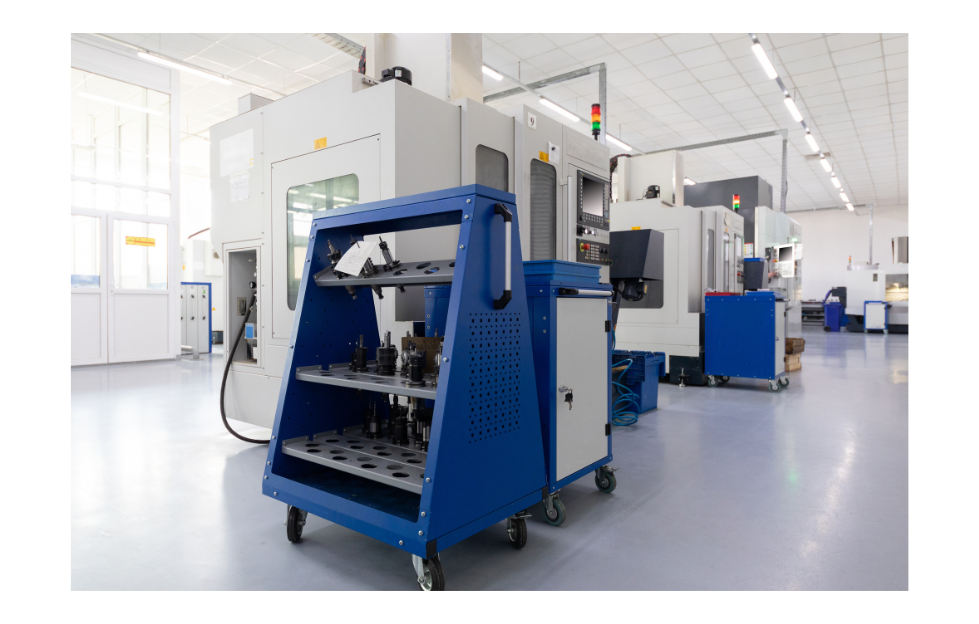Turning is a cornerstone of modern manufacturing, shaping countless components with precision and efficiency. From creating smooth finishes to achieving tight tolerances, the process is essential across various industries. In this article, you will learn about the different types of turning operations, the tools and materials involved, and the key advantages and challenges, gaining insight into why turning remains a critical machining method today.
What is turning?
Turning is a machining process where a cutting tool, typically a single-point tool, removes material from the outer surface of a rotating cylindrical workpiece. The workpiece is usually clamped in a lathe, and as it spins, the cutting tool moves along its axis to create precise shapes, such as cylindrical, conical, or even complex profiles. This method is commonly used to produce round components like shafts, pins, and bolts and is essential for achieving tight tolerances and smooth surface finishes, particularly through the use of Computer Numerical Control (CNC) turning.
Types of turning operations
There are many types of operations that turning machines can handle. This section will introduce you to each of these in detail.
1. Facing
A turning operation used to create a flat external surface on the end of a workpiece is known as facing. The cutting tool moves perpendicularly to the workpiece’s rotational axis, shaving material from the end to ensure a smooth, precise workpiece surface. This operation is commonly performed to prepare a part for subsequent machining steps, ensuring that the workpiece is uniformly flat and ready for accurate length measurements or additional cuts.
2. Straight Turning
In straight turning, the cutting tool moves parallel to the workpiece’s axis of rotation, reducing the diameter uniformly along the length of the part. This process results in a cylindrical shape with a consistent cross-section and is often used to achieve a specific diameter or prepare the workpiece for additional turning operations. It is fundamental in producing shafts, rods, and other cylindrical components that require precise tolerances, which are often achieved by carefully selecting the cutting parameters, such as depth of cut, feed rate, and cutting speed during machining.
3. Taper Turning
A conical shape on a workpiece is achieved through taper turning, where the cutting tool moves at a specific angle to the axis of rotation. This operation creates parts with varying diameters, such as machine tool spindles, pins, and conical fasteners. The taper can be achieved through various methods, including offsetting the tailstock, using a compound slide, or employing a taper attachment on the lathe.
4. Contour Turning
Complex, non-linear shapes on the surface of a workpiece are made possible with contour turning. This operation requires the cutting tool to follow a pre-programmed path, typically controlled by CNC (Computer Numerical Control) machines, to achieve the desired profile. It is ideal for parts with intricate curves or varying cross-sections, making it essential for industries like aerospace and automotive, where precision and complexity are critical.
5. Grooving
A narrow, recessed channel cut into the surface of a workpiece is referred to as grooving. The cutting tool plunges radially into the workpiece, forming grooves that can be used for snap rings, sealing O-rings, or aesthetic purposes. Grooving can be performed on both the outer diameter (external grooving) and the inner diameter (internal grooving) of a part, with precision being essential to ensure the groove meets dimensional specifications.
6. Parting (Cut-off)
Severing a finished piece from the remaining stock material is done through parting, or cut-off. The turning tool plunges into the workpiece perpendicularly to the axis, cutting through the material until the part separates. This operation is crucial for manufacturing processes involving mass production or when multiple components are made from a single workpiece, requiring a sharp tool to prevent deformation or damage to the part.
7. Threading
Helical grooves on the outer or inner surface of a cylindrical workpiece are created through threading. The cutting tool moves in synchronisation with the rotation of the workpiece, producing threads with specific pitch, depth, and angle. This operation requires careful attention to detail to ensure the threads engage properly with corresponding parts and can be performed manually or using CNC machines for high accuracy.
8. Boring
The process of enlarging an existing hole or cylindrical cavity in a workpiece to improve dimensional accuracy and surface finish is called boring. Using a single-point cutting tool, boring can adjust the diameter and refine the interior surface of a hole. This operation is often used when precision is critical, such as in engine cylinders, hydraulic components, or precision instrument housings, and is typically carried out on a lathe or a boring mill.
9. Drilling
Creating holes along the axis of a workpiece can be done through drilling, which is often performed on a lathe. The cutting tool, typically a drill bit, is fed into the rotating workpiece to produce a cylindrical hole. This process is commonly used to initiate holes for further machining operations, like boring or reaming, ensuring that the hole is centred and aligned accurately with the workpiece’s axis.
What are the machine tools used in the turning process?
The turning process utilises a variety of machine tools and equipment, each designed for specific operations and outcomes:
- Cutting Tools: These are the primary machine tools used in turning and typically include single-point cutting tools made from high-speed steel (HSS), carbide, or ceramic materials. The cutting tool’s geometry, including the angle and shape, is carefully selected to optimise the material removal rate and achieve the desired surface finish.
- Tool Holders: Tool holders secure the cutting tool in place and ensure stability during the turning operation. They are designed to minimise vibration and allow for precise positioning of the cutting tool, which is crucial for achieving accurate and consistent cuts.
- Chucks: Chucks are used to hold the workpiece firmly in place on the lathe. They come in different types, such as three-jaw chucks (for round or hexagonal workpieces) and four-jaw chucks (for square or irregularly shaped workpieces). Collet chucks and magnetic chucks are also used depending on the application and workpiece material.
- Centres: Centers, such as live centres and dead centres, are used to support the workpiece at the tailstock end, especially for longer or more flexible workpieces. They help maintain alignment and stability during the turning process.
- Lathe Machines: The lathe machine itself is a critical component, with various types of lathes like engine lathes, turret lathes, and CNC lathes. The machine rotates the workpiece while the cutting tool performs the material removal. CNC lathes are particularly important for high-precision and automated turning operations.
- Boring Bars: Boring bars are used for internal turning operations, such as enlarging a hole or cylindrical cavity in a workpiece. They are designed to minimise deflection and vibration, which is essential for maintaining accuracy when cutting inside the workpiece.
- Grooving and Parting Tools: These are specialised machine tools designed for grooving and parting operations. Grooving tools create channels or grooves, while parting tools are used to cut off a section of the workpiece. They are typically narrow and designed to minimise waste material.
- Threading Tools: Threading tools cut helical grooves in the workpiece to form threads. These tools can be single-point tools for external threading or internal threading tools for cutting threads inside a hole. Threading inserts are commonly used in CNC lathes for precision and repeatability.
- Drill Bits: Drill bits are used in turning processes to create holes along the axis of a rotating workpiece. They are typically mounted in the tailstock and fed into the workpiece to initiate holes, which can then be further processed through boring or threading.
- Form Tools: Form tools are used to cut complex shapes or profiles in a single pass. They are custom-shaped to match the desired contour of the workpiece and are often used in high-volume production to speed up the machining process.
Each tool and component plays a vital role in ensuring the efficiency, precision, and quality of the turning operation, with selections tailored to the material and design requirements of the part being machined.
What are the materials used for the turning process?
Materials used in the turning process for both workpieces and cutting tools are chosen based on the requirements of the operation, the desired properties of the finished part, and the tool’s durability. Here’s an overview:
Workpiece Materials
- Metals: Common metals include steel (carbon steel, alloy steel, stainless steel), aluminium, brass, copper, titanium, and cast iron. Steel is often selected for its strength and machinability, while aluminium is favoured for lightweight applications and ease of cutting.
- Plastics: Materials such as nylon, polypropylene, and polycarbonate are used when low weight, corrosion resistance, or electrical insulation is needed. These plastics can be easily machined but require different cutting tool geometries.
- Composites: Carbon fibre-reinforced polymers and fibreglass are machined in turning operations for lightweight yet strong components. Special tooling may be needed to handle these abrasive materials.
- Ceramics: Engineered ceramics are sometimes machined in turning processes for their high heat resistance and hardness, although these materials are generally more challenging to machine.
Cutting Tool Materials
- High-Speed Steel (HSS): HSS is used for general-purpose cutting tools because it offers good toughness and resistance to heat. It is suitable for lower-speed turning applications and when flexibility and sharpness are important.
- Carbide: Carbide tools are extremely hard and wear-resistant, making them ideal for high-speed turning operations and machining harder materials. They are commonly used in CNC lathes for precision and efficiency.
- Ceramic: Ceramic tools are used for high-speed machining of hard or abrasive materials. They have excellent heat resistance but are more brittle compared to carbide, so they are used in controlled environments for finishing operations.
- Cermet: A composite material made of ceramic and metallic materials, cermet tools provide a good balance of wear resistance and toughness, often used for fine finishing to achieve high surface quality.
- Cubic Boron Nitride (CBN): CBN is second only to diamond in hardness and is ideal for cutting hardened steels and superalloys. It is highly wear-resistant and retains cutting edges even at high temperatures.
- Polycrystalline Diamond (PCD): PCD tools are used for turning non-ferrous metals, composites, and plastics. They are extremely hard and provide a very smooth surface finish but are not suitable for cutting ferrous materials because of chemical reactivity.
- Tool Steels: Tool steels, including tungsten and molybdenum types, are used for cutting tools when durability and resistance to deformation are needed. These materials are common in specialised applications where HSS and carbide are not ideal.
The selection of both workpiece and cutting tool materials is critical to the success of the turning process, as it affects factors like cutting speed, tool life, surface finish, and overall efficiency.
Advantages and disadvantages of the turning process
Advantages:
- High Precision: Turning can achieve tight tolerances and high dimensional accuracy, making it ideal for parts that require precision.
- Versatility: Suitable for machining a wide variety of materials, including metals, plastics, and composites, and capable of producing various shapes like cylindrical, conical, and threaded parts.
- Smooth Surface Finish: Capable of producing smooth and uniform surfaces, reducing the need for additional finishing operations.
- High Efficiency with Automation: CNC lathes enhance productivity, enabling the rapid and consistent production of high-quality parts, especially for large quantities.
Disadvantages:
- Tool Wear: Cutting tools experience wear and tear, especially when machining hard materials or at high speeds, leading to increased maintenance and tool replacement costs.
- Material Limitations: Less effective for extremely hard or brittle materials, such as certain ceramics, which can lead to part breakage or faster tool wear.
- Complex Shape Limitations: Not suitable for machining very complex or intricate geometries that require multi-axis capabilities, limiting its application for certain parts.
- Setup Time and Constraints: Initial setup can be time-consuming, and the size of the workpiece is limited by the lathe’s capacity, restricting the machining of very large or heavy components.
Conclusion
Turning is an essential machining method that provides high precision, versatility, and efficiency, making it indispensable in many manufacturing settings. However, understanding the limitations, such as machine tool wear and the complexity of shapes achievable, is crucial for optimising its use. By selecting the appropriate tools and materials, and employing the right techniques, turning operations can deliver exceptional results tailored to specific production needs.










